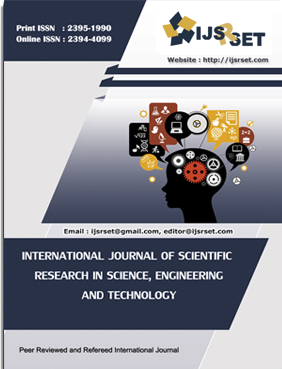A Comprehensive Review on Cryptography Algorithms: Methods and Comparative Analysis
DOI:
https://doi.org/10.32628/IJSRSET25121171Keywords:
Symmetric Key, Asymmetric Key, Post-Quantum Cryptography, Chaos-Based SystemsAbstract
The evolution of cryptography has been crucial to preservation subtle information in the digital age. From early cipher algorithms implemented in earliest societies to recent cryptography methods, cryptography has developed alongside developments in computing field. The growing in cyber threats and the increase of comprehensive digital communications have highlighted the significance of selecting effective and robust cryptographic techniques. This article reviews various cryptography algorithms, containing symmetric key and asymmetric key cryptography, via evaluating them according to security asset, complexity, and execution speed. The main outcomes demonstrate the growing trust on elliptic curve cryptography outstanding its capability and small size, while highlighting the requirement for study in the post-quantum cryptographic field to address the threats rising from quantum computing. The comparative analysis shows a comprehensive understanding that combines classical cryptography algorithms with up-to-date approaches such as chaotic-based system and post-quantum cryptography, confirming that the study addresses the future of cryptography security in the aspect of emerging challenge like quantum computing.
📊 Article Downloads
References
Schneier, B. (1996). Applied Cryptography. John Wiley & Sons.
Stallings, W. (2017). Cryptography and Network Security: Principles and Practice, 7th ed., Pearson.
M. Husam, A. Kamel, D. F. Chalob, and Z. M. Abood. (2020). "Safe Fingerprint Analysis Technique Employed in Passport Verification for Sustainable Development". Journal of Green Engineering, vol. 10, no. 9, pp. 6103–6114.
Fluhrer, S., Mantin, I., & Shamir, A. (2001). "Weaknesses in the key scheduling algorithm of RC4." Proceedings of the 8th Annual International Workshop on Selected Areas in Cryptography. DOI: https://doi.org/10.1007/3-540-45537-X_1
Bernstein, D. J. (2008). "ChaCha, a variant of Salsa20". The Second Open Workshop on the Cryptography and Security of TLS.
Daemen, J., & Rijmen, V. (2002). "The Design of Rijndael: AES – The Advanced Encryption Standard. Springer". Berlin. DOI: https://doi.org/10.1007/978-3-662-04722-4_1
W. A. Shukur, L. K. Qurban, and A. Aljuboori. (2023). "Digital Data Encryption Using a Proposed W-Method Based on AES and DES Algorithms". Baghdad Sci.J [Internet], vol. 20, no. 4, pp. 1414-1424. doi:10.21123/bsj.2023.7315. DOI: https://doi.org/10.21123/bsj.2023.7315
Adeniyi, A.E.; Misra, S.; Daniel, E.; Bokolo, A., Jr. (2022). "Computational Complexity of Modified Blowfish Cryptographic Algorithm on Video Data". Algorithms, vol. 15, no. 373. doi:10.3390/a15100373. DOI: https://doi.org/10.3390/a15100373
Rivest, R. L., Shamir, A., & Adleman, L. (1978). "A method for obtaining digital signatures and public-key cryptosystems." Communications of the ACM, 21(2), 120-126. DOI: https://doi.org/10.1145/359340.359342
Koblitz, N., "Elliptic Curve Cryptosystems. (1987). " Mathematics of Computation, 48(177), pp. 203-209. DOI: https://doi.org/10.1090/S0025-5718-1987-0866109-5
Jebrane, J.; Chhaybi, A.; Lazaar, S.; Nitaj, A. (2025). "Elliptic Curve Cryptography with Machine Learning". Cryptography, Vol. 9, No. 3. doi:10.3390/ cryptography9010003. DOI: https://doi.org/10.3390/cryptography9010003
E. Järpe. (2020). "An Alternative Diffie–Hellman Protocol". Cryptography, vol. 4, no. 1, Art. 5. doi: 10.3390/cryptography4010005. DOI: https://doi.org/10.3390/cryptography4010005
Adeniyi, E.A.; Falola, P.B.; Maashi, M.S.; Aljebreen, M.; Bharany, S. (2022). "Secure Sensitive Data Sharing Using RSA and ElGamal Cryptographic Algorithms with Hash Functions". Information, 13, 442. Doi:10.3390/ info13100442. DOI: https://doi.org/10.3390/info13100442
Steichen, M.; Fiz Pontiveros, B.; Norvill, R.; Shbair, W. (2018). "Blockchain-Based, Decentralized Access Control for IPFS". In Proceedings of the 2018 IEEE International Conference on Blockchain (Blockchain-2018), Halifax, NS, Canada, pp. 1499–1506. DOI: https://doi.org/10.1109/Cybermatics_2018.2018.00253
Zhang, B.; Liu, L. (2023). "Chaos-Based Image Encryption: Review, Application, and Challenges". Mathematics, 11, 2585. Doi:10.3390/math11112585. DOI: https://doi.org/10.3390/math11112585
D. F. Chalob, R. H. Hasan, and R. F. Yaser. (2024). "Image Cryptography Based on Confusion and Diffusion Using 6D Hyper Chaotic System and Fibonacci Q-matrix". International Journal of Intelligent Engineering and Systems, vol. 17, no. 4, pp. 944-956. doi:10.22266/ijies2024.0831.71. DOI: https://doi.org/10.22266/ijies2024.0831.71
D. F. Chalob, R. H. Hasan, & F. N. Abbas. "Image Encryption based on Chaotic Blocks Shuffling and RC4. " Baghdad Sci.J [Internet]. [cited 2025 Feb. 8];22(6).
D. F. Chalob, A. A. Maryoosh, Z. M. Essa, and E. N. Abbud. (2020). "A New Block Cipher for Image Encryption Based on Multi Chaotic Systems". TELKOMNIKA Telecommunication, Computing, Electronics and Control, vol. 18, no. 6, pp. 2986-2994. doi: 10.12928/TELKOMNIKA.v18i6.13746. DOI: https://doi.org/10.12928/telkomnika.v18i6.13746
Talha Umar, Mohammad Nadeem, Faisal Anwer. (2024). "Chaos based image encryption scheme to secure sensitive multimedia content in cloud storage". Expert Systems with Applications, Vol. 257, 125050. doi: 10.1016/j.eswa.2024.125050. DOI: https://doi.org/10.1016/j.eswa.2024.125050
Dam, D.-T.; Tran, T.-H.; Hoang, V.-P.; Pham, C.-K.; Hoang, T.-T. (2023). "A Survey of Post Quantum Cryptography: Start of a New Race". Cryptography, 7, 40. doi: 10.3390/cryptography7030040. DOI: https://doi.org/10.3390/cryptography7030040
Asif, R. (2021). "Post-Quantum Cryptosystems for Internet-of-Things: A Survey on Lattice-Based Algorithms". IoT, 2, 71–91. doi.org/10.3390/iot2010005. DOI: https://doi.org/10.3390/iot2010005
G. Alagic, D. Apon, D. Cooper, Q. Dang, T. Dang, J. Kelsey, J. Lichtinger, Y.-K. Liu, C. Miller, D. Moody, R. Peralta, R. Perlner, A. Robinson, and D. Smith-Tone. (2022). "Status Report on the Third Round of the NIST Post-Quantum Cryptography Standardization Process". NIST Interagency or Internal Report NIST IR 8413 upd1, 102 pp. doi:10.6028/NIST.IR.8413-upd1. DOI: https://doi.org/10.6028/NIST.IR.8413
Moody, D. , Alagic, G. , Apon, D. , Cooper, D. , Dang, Q. , Kelsey, J. , Liu, Y. , Miller, C. , Peralta, R. , Perlner, R. , Robinson, A. , Smith-Tone, D. and Alperin-Sheriff, J. (2020), Status Report on the Second Round of the NIST Post-Quantum Cryptography Standardization Process, NIST Interagency/Internal Report (NISTIR), National Institute of Standards and Technology, Gaithersburg, MD. doi.org/10.6028/NIST.IR.8309. DOI: https://doi.org/10.6028/NIST.IR.8309
Downloads
Published
Issue
Section
License
Copyright (c) 2025 International Journal of Scientific Research in Science, Engineering and Technology

This work is licensed under a Creative Commons Attribution 4.0 International License.




